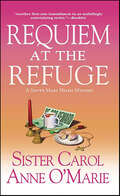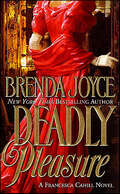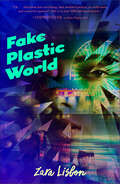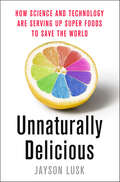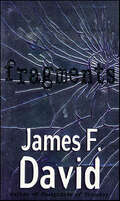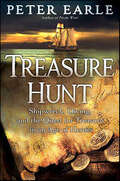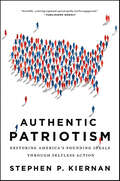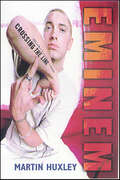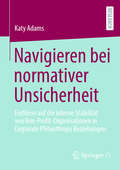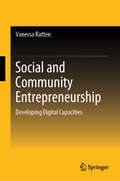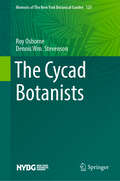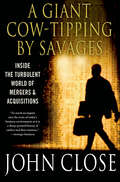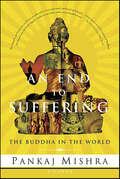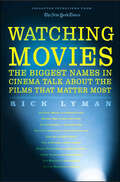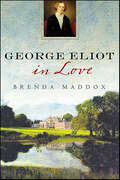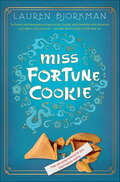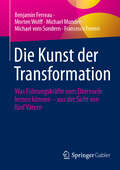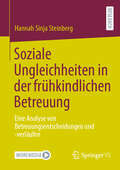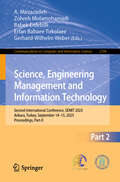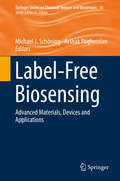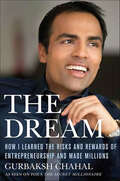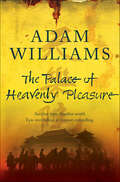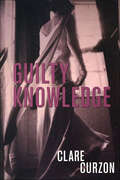- Table View
- List View
Requiem at the Refuge (Sister Mary Helen Mysteries)
by Carol Anne O'Marie"A San Francisco nun... author [O’Marie] evokes convent life in the 90s with simple reverence and gentle humor." - Publishers WeeklySister Mary Helen is dismayed when, after the unexpected death of Sister Cecilia, the president of Mount St. Francis College, Sister Patricia is appointed the post. Sister Mary Helen is not in the new president's best graces and feels she surely will be asked to retire. But the chance to volunteer at a drop-in center for abused women and serve on the board quite revives Sister Mary Helen's flagging spirits -- until a young woman who frequents the center is murdered.
Deadly Pleasure (The Francesca Cahill Novels)
by Brenda JoyceBrenda Joyce has enthralled millions of readers with her New York Times bestselling novels. Now, join us in the next chapter of her unforgettable storytelling: the Francesca Cahill novels. Step into the glittering world of New York City's high society at the turn of the last century, where murder and pleasure are one and the same, and love becomes the ultimate weapon...Francesca Cahill comes from one of New York's best families. Her mother is a leading socialite, her father, a millionaire. Their expectations for their daughter are simple-- marry well, and soon. But the intrepid and self-styled "Crime-Solver Extraordinaire" has other plans...Francesca discovered she had a penchant for sleuthing when she met Rick Bragg, New York City's powerful and enigmatic Police Commissioner. Together, they solved what was known as the crime of the century. Now, their paths are destined to come together once again, but this time far more dangerously and fatefully. For Francesca is tempted to give in to the desire she and Rick have been resisting. And when Bragg's arch-rival Calder Hart arrives in town, a respectable man is suddenly found dead, and now murder is the name of the game...
Fake Plastic World
by Zara LisbonYouth, beauty, and the perils of fame combine in Zara Lisbon's Fake Plastic World, the suspenseful sequel to Fake Plastic Girl.How badly do you want to be famous? What—or who—would you sacrifice?These are the questions Justine Childs is forced to reckon with as the main suspect in the murder of It-girl Eva-Kate Kelly. Not long ago, Eva-Kate drew Justine into her orbit before meeting her untimely end in a Venice Beach canal. Prosecutors and the public want to know: Did Justine, now a social media darling in her own right, kill her celebrity best friend? Can anyone be trusted to tell the truth? Justine has always wanted people to know her name—but not all notoriety is created equal.
Unnaturally Delicious: How Science and Technology Are Serving Up Super Foods to Save the World
by Jayson LuskThe food discussion in America can be quite pessimistic. With high obesity rates, diabetes, climate change, chemical use, water contamination, and farm animal abuse, it would seem that there wasn't very much room for a positive perspective. The fear that there just isn't enough food has expanded to new areas of concern about water availability, rising health care costs, and dying bees.In Unnaturally Delicious, Lusk makes room for optimism by writing the story of the changing food system, suggesting that technology and agriculture can work together in a healthy and innovative way to help solve the world's largest food issues and improve the farming system as we know it.This is the story of the innovators and innovations shaping the future of food. You’ll meet an ex-farmer entrepreneur whose software is now being used all over the world to help farmers increase yields and reduce nutrient runoff and egg producers who’ve created new hen housing systems that improve animal welfare at an affordable price. There are scientists growing meat in the lab. Without the cow. College students are coaxing bacteria to signal food quality and fight obesity. Nutrient enhanced rice and sweet potatoes are aiming to solve malnutrition in the developing world. Geneticists are creating new wheat varieties that allow farmers sustainably grow more with less. And, we’ll learn how to get fresh, tasty, 3D printed food at the touch of a button, perhaps even delivered to us by a robotic chef. Innovation is the American way. Thomas Jefferson, George Washington Carver, and John Harvey Kellogg were food and agricultural entrepreneurs. Their delicious innovations led to new healthy, tasty, convenient, and environmentally friendly food. The creations were unnaturally delicious. Unnatural because the foods and practices they fashioned were man-made solutions to natural and man-made problems. Now the world is filled with new challenges changing the way we think about food. Who are the scientists, entrepreneurs, and progressive farmers who meet these challenges and search for solutions? Unnaturally Delicious has the answers.
Fragments
by James F. DavidA team of psychologists has gathered in a small college town to conduct a revolutionary experiment: To find five "savants" with extreme and diverse aptitudes, in order to create a sixth composite intelligence using new cybernetic technology. The first experiments show promise, but a terrifying secret from the past will transform the project in ways the researchers never anticipated--and infect the newborn intelligence with a catastrophic thirst for vengeance."Its thought-provoking subject notwithstanding, David's tale is an action-packed no-brainer full of guilty pleasures for even the most cerebral reader." - Publishers WeeklyAt the Publisher's request, this title is being sold without Digital Rights Management Software (DRM) applied.
Treasure Hunt: Shipwreck, Diving, and the Quest for Treasure in an Age of Heroes
by Peter Earle"A remarkable book, in which a very wide spectrum of human behavior is on show---from colossal gullibility on the one hand, to extraordinary ingenuity and determination on the other." —The Daily Telegraph (UK)Treasure Hunt is the story of an obsession. Rumors of Spanish treasure, or gold and silver at the bottom of the sea, have been a part of maritime lore for centuries. In 1687, Captain William Phips brought back to port an incredible cargo---nearly forty tons of silver and gold---the treasure of the Spanish galleon Concepción, wrecked over forty years before on a coral reef in the middle of the ocean. The unimaginable had become real, and the great treasure-hunting boom had begun. Soon after Phips's success, there were numerous expeditions that meant to emulate his stunning achievement. During that same time there was also a boom in the invention of crude and often very dangerous diving equipment. Many of these new projects were promoted on the infant stock market, where gambling and treasure hunting became closely connected with the birth of modern capitalism. By the eighteenth and nineteenth centuries, treasure hunting had become a professional occupation, with a new breed of diver emerging. Much of their time was spent salvaging the wrecks of English and Dutch East-Indiamen carrying treasure to finance business in Asia. Ever since, men have been prepared to risk life and fortune in the search for underwater riches. The author of numerous books of maritime history, including The Pirate Wars and The Sack of Panamá, world-renowned historian Peter Earle returns with an extraordinary and little-known history---of outstanding bravery, of exceptional recklessness, and above all, of the unquenchable lust for treasure.
Authentic Patriotism: Restoring America's Founding Ideals Through Selfless Action
by Stephen P. KiernanAuthentic Patriotism presents a provocative, inspiring account of our neglected American ideals and the people who are living them today.Patriotism has become a loaded word: one that is wielded against people with whom we might disagree, or whose cultural origins don't match our own. But our founding fathers--Washington, Jefferson, Adams, and others--saw patriotism as a dynamic force: an act of service, in an evolving nation that defined its purpose by offering all people a better way of life. In Authentic Patriotism, author and award-winning journalist Stephen P. Kiernan explores the original ideals that have been lost in our current climate, where war and economic turmoil have eroded our sense of civic obligation. Kiernan describes "a nation adrift," out of touch with its origins--and then introduces a range of inspiring people who have revived our national purpose by taking action: - The out-of-work college graduate who led an economic and environmental renewal of her blighted home community.- The retired executive who pioneered a revolutionary concept in health care for people without insurance.- The minister who created a legendary choir, with the goal of uniting children of different races, genders, and classes in one voice.- The family who donated their daughter's heart, so that another might live. These and other "New Americans" are profiled in a book that offers hope, ideas, examples, and practical resources for readers who want to renew the American spirit.
Eminem: Crossing the Line
by Martin Huxley"God sent me to piss the world off," Eminem boasts on his breakthrough hit "My Name Is." A grandiose claim to be sure, but it's hard to imagine another rapper generating as much controversy and outrage as this bleach-blonde Detroit MC outlaw while still selling millions of records and becoming a hero to pop fans and hardcore hip-hop purists alike. The sharp-tongued product of crushing poverty and an unstable homelife, Eminem is much more than the goofy smartass he usually portrays himself as. Beyond the artist's inventive rhyming skills and appealingly warped lyrical persona, the multi-platinum major-label albums The Slim Shady LP and The Marshall Mathers LP present a dark, psychologically complex character whose vivid, vengeful rhymes embody a timely collision of Midwestern white trash and urban hip-hop cultures, while portraying an unpredictably violent yet absurdly hilarious world. Adopting the cartoonish yet unsettling persona of Slim Shady, Eminem spins colorfully absurd narratives involving sadistic violence while reflecting the tortured psyche of a deeply conflicted character whose real-life pain lurks beneath the surface of his outrageous alter ego.It's those contradictions that help make Eminem a uniquely compelling artist whose primal appeal transcends boundaries of race and musical genre. Eminem: Crossing the Line, the first biography ever written of this unique pop-culture icon, offers a fascinating peek into the strange and twisted world of Slim Shady.
Navigieren bei normativer Unsicherheit: Einflüsse auf die interne Stabilität von Non-Profit-Organisationen in Corporate Philanthropy Beziehungen
by Katy AdamsObwohl Beziehungen zwischen Unternehmen und Non-Profit-Organisationen weit verbreitet sind, ist wenig darüber bekannt, welche Auswirkungen sie auf die interne Stabilität der Non-Profit-Organisationen haben. Dieses Buch zeigt nicht nur den Bedarf an solchem Wissen, sondern auch die vielfältigen und vielstimmigen Einflüsse auf die Wahrnehmung einer solchen Beziehung durch Non-Profit-Mitarbeitende und die daraus resultierende Bindung zwischen ihnen und ihrer Organisation. Auf diese Weise wird deutlich, dass die langfristigen Folgen der Beziehungen zwischen Unternehmen und Non-Profit-Organisationen in der Verantwortung aller Beteiligten und des gesamten Sektors liegen.
Protect the Water World: Selected Papers of 2024 International Conference on Environmental Protection and Pollution Control (EPPC 2024) (Environmental Science and Engineering)
by Varenyam Achal Ahmad Zuhairi Abdullah Mohd Razif HarunThis book unveils the advancements in water pollution analysis and its biological treatment technology and provides valuable research and experience for engineers and scholars. On March 22, 2024, in the United Nations World Water Development Report, the theme of this year's conference, "Water for Promoting Prosperity and Peace," aligns with Global Water Partnerships' long-standing mission and vision of integrated water resources management. Currently, around half of the world's population faces severe water scarcity for at least part of the year, and a quarter of the global population experiences "extremely high" water stress. Meanwhile, global freshwater usage is growing at a rate slightly below 1% annually. Hence, the protection of water resources and pollution control, particularly the renewal and management of freshwater resources, deserve significant attention. Emerging pollutants of concern include per- and polyfluoroalkyl substances (PFAS), pharmaceuticals, hormones, industrial chemicals, detergents, cyanotoxins, and nanomaterials. High concentrations of antimicrobial agents have been found worldwide, originating from inadequately treated household wastewater, livestock, and aquaculture. Biological treatment technology for water pollution uses microorganisms to break down pollutants into harmless or less toxic substances, becoming an important means of addressing water pollution. Its advantages lie in low cost, adaptability, and the ability to effectively treat various organic pollutants, including hydrocarbons, pharmaceuticals, and pesticides. However, the effectiveness of this technology depends on the selection of appropriate microbial strains and the optimization of treatment conditions (such as temperature, pH, and nutrients). In the aspect of water pollution analysis, accurate detection of the types and concentrations of pollutants is a prerequisite for management and remediation. Modern instruments, such as gas chromatography-mass spectrometry (GC-MS) and liquid chromatography-mass spectrometry (LC-MS), can identify and quantify trace pollutants in complex water bodies. Additionally, new-generation sensing technologies and biological detection tools, like DNA microarrays and gene sequencing technologies, enable rapid detection of specific pollutants and reveal microbial community responses to pollutants. These technologies can effectively target and treat heavy industrial and chemical pollution, thereby protecting water environmental safety. This book aims to facilitate the exchange of scientific information among scholars from leading universities, research centers, and high-tech enterprises around the world. This book is highly beneficial to scholars, engineers, and researchers in the fields of environmental engineering and water pollution.
Social and Community Entrepreneurship: Developing Digital Capacities
by Vanessa RattenThis book focuses on both social and community developments within an entrepreneurship perspective, thereby highlighting the need to foster public and non-profit initiatives that combine with financial needs. Social and community entrepreneurship is a distinct form of entrepreneurship that combines profit and non-profit initiatives. This book helps to encourage social and community enterprises to integrate digital capabilities. Specific business examples of social digital enterprises will be discussed in the textbook together with community-led initiatives.
The Cycad Botanists (Memoirs of The New York Botanical Garden #123)
by Roy Osborne Dennis Wm. StevensonThis work provides short biographies of 50 historical figures in cycad biology. It covers those starting in the early 17th century through the 21st century. Each of the biographies covers a career including birth and death, schooling, places of employment, travel in field work, publications, place of their cycad type specimens, list of species described and list of species named for them. The latter two items are illustrated along with any honorific items such as currency, stamps, and so on. Additionally, each entry has a portrait. The purpose of this work is to bring together in one place treatments on the lives, work, publications, illustrations, and type specimens of the historic figures in cycad biology. It will be of interest to researchers in cycads but also to the large, amateur community of cycad enthusiasts and others interested in gymnosperms and the history of botany. The book will be featured at the triennial meetings on cycad biology at New York Botanical Garden.
A Giant Cow-Tipping by Savages: Inside the Turbulent World of Mergers & Acquisitions
by John CloseModern mergers and acquisitions, or M&A as it's more commonly known, is a new phenomenon. The buying and selling, the breaking up and combining of companies-the essence of M&A-has been a part of commerce throughout history, but only in our era has M&A itself become a business. In 2007, before the recession hit, it was a $4.4 trillion global enterprise. And yet, it remains largely unexplored. Discrete stories have been pulled from the annals of M&A, both true and fictionalized, that have become touchstones for wealth and excess. Who can forget Gordon Gekko and his "Greed is Good" speech? But while there have been a few iconic characters and tales to emerge, no one has told the rich history of M&A, until now. This is a look into that world and the people who created it. This reads like Dallas meets Wall Street, told through an intriguing narrative that not only brings to light in gritty detail all of the back room drama of such powerful players as Carl Icahn and Ronald Perelman, Marty Lipton and Joe Flom, Jimmy Goldsmith and Sumner Redstone, but also reveals how the new generation, including activist whirlwind Bill Ackman and iconoclastic new Delaware judge Leo Strine, will dominate the next tsunamic, and imminent, M&A boom.
An End to Suffering: The Buddha in the World
by Pankaj MishraA searching, personal portrait of the Buddha and his enduring influence, East and West.Pankaj Mishra's An End to Suffering is a deeply original and provocative book about the Buddha's life and his influence throughout history, told in the form of the author's search to understand the Buddha's relevance in a world where class oppression and religious violence are rife, and where poverty and terrorism cast a long, constant shadow. Mishra describes his restless journeys into India, Pakistan, and Afghanistan, among Islamists and the emerging Hindu middle class, looking for this most enigmatic of religious figures, exploring the myths and places of the Buddha's life, and discussing Western explorers' "discovery" of Buddhism in the nineteenth century. He also considers the impact of Buddhist ideas on such modern politicians as Gandhi and Nelson Mandela.As he reflects on his travels and on his own past, Mishra shows how the Buddha wrestled with problems of personal identity, alienation, and suffering in his own, no less bewildering, times. In the process Mishra discovers the living meaning of the Buddha's teaching, in the world and for himself. The result is the most three-dimensional, convincing book on the Buddha that we have.
Watching Movies: The Biggest Names in Cinema Talk about the Films that Matter Most
by Rick LymanAn inside look at how some of the biggest names in the film industry view their craftIn this unique collection, New York Times film critic Rick Lyman sits down with notable directors, actors, screenwriters, cinematographers, and other film industry professionals to watch and discuss a movie that each person considers seminal or influential on his or her career. Steven Soderbergh on how All the President's Men influenced Erin Brockovich* Quentin Tarantino on The Golden Stallion* Ang Lee on Love Eternal* Denzel Washington on Ordinary People* Ron Howard on The Graduateand many moreEach interviewee's character is revealed in the resulting essays, which deepen our appreciation of landmark films, and give us extraordinary insight into the process of filmmaking.Lyman enhances every essay with a brief biography, career history, and complete filmography of each of the subjects, which puts them in a historical and creative context. Drawn from the enormously popular series in The New York Times, Watching Movies will fascinate film students and curious moviegoers alike.
George Eliot in Love
by Brenda MaddoxGeorge Eliot is one of the most celebrated novelists in history. Her books, including Middlemarch, Daniel Deronda, and Adam Bede, are as appreciated now as they were in the nineteenth century. Yet her nonconformist and captivating personal life—a compelling story in itself—is not well known. Ridiculed as an ugly duckling, Eliot violated strict social codes by living with a married man for most of her adult life. Soon after he died, she married a much younger man who attempted suicide during their honeymoon. The obstacles Eliot overcame in her life informed her work and have made her legacy an enduring one. Brenda Maddox brings her lively style to bear on the intersection of Eliot's life and novels. She delves into the human side of this larger-than-life figure, revealing the pleasure and pain behind the intellectual's public face. The result is a deeply personal biography that sheds new light on a woman who lived life on her own terms and altered the literary landscape in the process.
Miss Fortune Cookie
by Lauren BjorkmanMeet Erin. Smart student, great daughter, better friend. Secretly the mastermind behind the popular advice blog Miss Fortune Cookie. Totally unaware that her carefully constructed life is about to get crazy.It all begins when her ex-best friend sends a letter to her blog—and then acts on her advice. In this novel from Lauren Bjorkman, Erin's efforts to undo the mess will plunge her into adventure, minor felonies, and possibly her very first romance.What's a likely fortune for someone no longer completely in control of her fate? Hopefully nothing like: You will become a crispy noodle in the salad of life.
The Influence of Environment on Mechanical Characteristics of Key Semiconductor Components
by Joshua PellegThis book provides a comprehensive overview of the impact of environmental constituents on the mechanical properties of semiconductors. Chapter 1 sets the stage by outlining the various environmental constituents that can have deleterious effects on both the mechanical properties of materials and the health of those who handle them. This includes gases such as oxygen, nitrogen, hydrogen, air, and moisture in the air, some of which are responsible for greenhouse gas emissions that directly affect the climate. Chapters 2 through 12 delve into specific aspects of mechanical behavior, including elastic properties, plastic deformation, defects, hardness, brittle behavior, impact testing, deformation processes, and time-dependent deformation. The book also examines how the behavior of semiconductors differs at the nano scale and provides insights into improving their mechanical properties. This book is a valuable resource for researchers, engineers, and students inthe fields of materials science and engineering, semiconductor technology, and nanotechnology. It highlights the urgent need to assess the global environmental impacts of these materials and suggests alternate uses for their production in order to preserve life on earth.
Die Kunst der Transformation: Was Führungskräfte vom Elternsein lernen können – aus der Sicht von fünf Vätern
by Benjamin Ferreau Morten Wolff Michael Munder Michael vom Sondern Francesco FerreriEs ist Zeit für Veränderung und neue Perspektiven – das haben sich auch die Autoren dieses Buchs gedacht: Fünf Väter, zugleich Unternehmer und Führungskräfte, die aufzeigen, dass in erfolgreichen Transformationsprozessen oft gerade die Kompetenzen entscheidend sind, die sie als Väter täglich erproben. Dieses Buch ist das Ergebnis von fünf Lebensläufen und es geht um Transformation – auf beruflicher Ebene, aber auch auf persönlicher Ebene. In der Business-Welt überschlagen sich seit Jahren die Themen, die Disruption kommt von allen Seiten und der Druck auf Unternehmen steigt rasant. Sie müssen reagieren – meist mit umfangreichen Transformationen. Herzstück des Buches bilden die persönlichen Geschichten aus dem Alltag als Väter und die Übertragung der geschilderten Fähigkeiten in den Berufsalltag. Zusätzlich bieten sie mit dem „Transformation Design Model&“ ein praxisorientiertes und pragmatisches Modell für die operative Umsetzung an. Ziel der Autoren ist es, die „Kunst der Transformation&“ so einfach wie möglich zu beschreiben und Führungskräften diese Inspiration weiterzugeben, um eine neue Perspektive auf die Transformation von Unternehmen zu eröffnen.
Soziale Ungleichheiten in der frühkindlichen Betreuung: Eine Analyse von Betreuungsentscheidungen und -verläufen
by Hannah Sinja SteinbergWie treffen Eltern Entscheidungen über frühkindliche Betreuung, und welche Rolle spielt dabei die soziale Herkunft? Dieses Buch beleuchtet die Mechanismen, die soziale Ungleichheiten in Betreuungsentscheidungen für Kinder unter drei Jahren prägen – ein Bereich, der sowohl für die Förderung der kindlichen Entwicklung als auch für die Vereinbarkeit von Familie und Beruf von zentraler Bedeutung ist. Die Arbeit erweitert das Verständnis frühkindlicher Betreuung durch eine dynamische Perspektive: Neben der Nutzung oder Nicht-Nutzung formeller Angebote stehen das Timing und die Muster der Betreuungsverläufe im Fokus. Basierend auf einer Kombination von Rational-Choice-Modellen und dem Lebensverlaufsansatz liefert die Analyse empirisch fundierte Einblicke in soziale Disparitäten und den Einfluss institutioneller Rahmenbedingungen. Die Ergebnisse zeigen, wie selektive Betreuungsentscheidungen nicht nur bestehende Ungleichheiten widerspiegeln, und somit die Startchancen und Bildungsbiografien von Kindern nachhaltig beeinflussen können. Abschließend eröffnet die Arbeit Handlungsperspektiven für Politik und Praxis, um gerechtere Betreuungszugänge zu fördern.
Science, Engineering Management and Information Technology: Second International Conference, SEMIT 2023, Ankara, Turkey, September 14–15, 2023, Proceedings, Part-II (Communications in Computer and Information Science #2199)
by Gerhard-Wilhelm Weber Zohreh Molamohamadi Erfan Babaee Tirkolaee Babek Erdebilli A. MirzazadehThis two-volume set constitutes selected papers presented during the Second International Conference on Science, Engineering Management and Information Technology, SEMIT 2023, held in Ankara, Turkey, during September 14–15, 2023. The 44 full papers and 2 short papers presented were carefully reviewed and selected from 409 submissions. The papers cover the following topics: Part I - Decision Analysis and Expert Systems; Machine Learning, Data Analysis and Computer Vision in Healthcare and Medicine; Smart Production, Transportation and Supply Chain Systems; Information Technology and Data Science in Industry. Part II - IoT, Blockchain, and Cyber Security in Complex Systems; Real-Time Data Analysis and Simulation in Engineering Systems; Digitalization and Artificial Intelligence in Manufacturing/ Service Industries; Soft Computing and Artificial Intelligence in Engineering Management and Marketing.
Label-Free Biosensing: Advanced Materials, Devices and Applications (Springer Series on Chemical Sensors and Biosensors #16)
by Michael J. Schöning Arshak PoghossianThis volume summarizes the state-of-the-art technologies, key advances and future trends in the field of label-free biosensing. It provides detailed insights into the different types of solid-state, label-free biosensors, their underlying transducer principles, advanced materials utilized, device-fabrication techniques and various applications. The book offers graduate students, academic researchers, and industry professionals a comprehensive source of information on all facets of label-free biosensing and the future trends in this flourishing field. Highlights of the subjects covered include label-free biosensing with:· semiconductor field-effect devices such as nanomaterial-modified capacitive electrolyte-insulator-semiconductor structures, silicon nanowire transistors, III-nitride semiconductor devices and light-addressable potentiometric sensors· impedimetric biosensors using planar and 3D electrodes· nanocavity and solid-state nanopore devices · carbon nanotube and graphene/graphene oxide biosensors· electrochemical biosensors using molecularly imprinted polymers· biomimetic sensors based on acoustic signal transduction· enzyme logic systems and digital biosensors based on the biocomputing concept· heat-transfer as a novel transducer principle· ultrasensitive surface plasmon resonance biosensors · magnetic biosensors and magnetic imaging devices
The Dream: How I Learned the Risks and Rewards of Entrepreneurship and Made Millions
by Gurbaksh ChahalOne of America's most successful young internet entrepreneurs tells his unique and inspiring story, and reveals the risks and rewards behind the sky's-the-limit possibilities of internet entrepreneurship.Gurbaksh Chahal started the Internet advertising company ClickAgents from his bedroom at the age of 16, having emigrated to the United States with his Sikh family from the small town of Tarn Taran, India. He dropped out of high school to pursue the venture full-time, and two years later sold ClickAgents for $40 million, making him one of the youngest self-made millionaires in history and allowing him and his entire family to realize their dreams. Chahal went on to become the youngest executive of a multi-billion dollar NASDAQ-listed company, and then sold his second company, BlueLithium, to Yahoo! for $300 million, turning many of his employees into multi-millionaires as well. In The Dream, Chahal's refreshing advice for entrepreneurs encourages them to embrace risk and to carve out new niches in the marketplace. He emphasizes the value of good business timing: how to execute an idea and get it to the marketplace, how to create and maintain solid business relationships, how to stay grounded, and-- most importantly--how to teach yourself that failure is not an option. Chahal's story not only shows how a 16-year-old immigrant overcame discrimination and adversity to fulfill his highest ambitions, but also provides aspiring entrepreneurs with valuable hands-on advice on how to achieve success.
The Palace of Heavenly Pleasure
by Adam WilliamsNorthern China, 1899. As the Boxer Rebellion erupts, a cast of innocents, fanatics, sinners, and lovers are drawn to the Palace of Heavenly Pleasure - an infamous brothel that overlooks an execution ground - where the fury of the East will meet the ideals of the West and all will face their destiny. Adam Williams's first novel is a historical tour-de-force and a triumphant return to traditional storytelling on a truly grand scale.
Guilty Knowledge
by Clare CurzonClare Curzon turns aside temporarily from Inspector Mike Yeadings and crime in today's Thames Valley to bring us to Edwardian England. In this tale of bygone evil and present-day deceit, Curzon demonstrates that she is as adept as delivering a page-turner in a different time period as she is in spinning a tale of crime in present-day Wales. This is a story about two titled women, Lady Isabelle Delmayne and Eugenie, Countess Crowthrowne, who share a dark past. Implicated in two vicious murders seven years earlier, they both have histories of naked ambition, duplicity, moral blackmail and betrayal. Inescapably locked together in their knowledge of one another's secrets, they struggle desperately for the upper hand, each aware that a betrayal of the other's past could bring them her down along with her enemy. The tension climaxes when a summer storm breaks the terrible heatwave of 1908 and the body of a foreigner, bludgeoned to death, is found in the river near the home they unfortunately share. The discovery and the ensuing police inquiry opens the floodgates of their joint and separate pasts, with all its dangerous ghosts and new evidence of a similar death that took place when they were together on a tour of Europe. In the face of these shocking revelations, police and family members contend over whether the women can be held accountable at this date, or whether, as the family wishes, the whole sorry picture can be conveniently swept under the carpet. It is in this infighting, as well as the crimes that come to light, that Curzon holds the reader's attention until the very last page.
